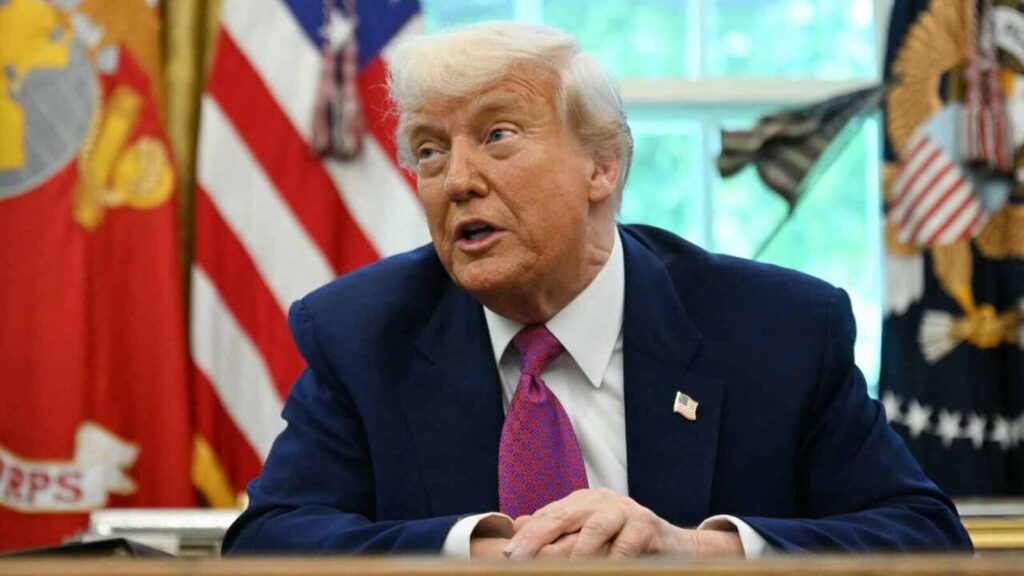Just when the stock market was getting comfortable with your agenda again, you had to go and shake things up.
There was your keyboard, so tempting, and you couldn’t help posting new tariff threats on Apple and Europe, sparking a pre-Memorial Day slump. There was your “big, beautiful bill,” which finally passed the House of Representatives but spooked the Treasury market because it would increase the national debt by $3.1 trillion, including interest, over the coming decade. And don’t forget the Supreme Court, which may or may not have given you the ability to fire the chairman of the Federal Reserve. The S&P 500 index fell 2.6% this past week, its largest weekly loss since April 4.
Still, it seems far too easy to blame the self-described Tariff Man for the stock market’s bad week. It wasn’t President Donald Trump who rushed in to buy so much stock that the S&P 500 rose 19.6% from its low on April 8 through May 8, erasing all its Liberation Day losses and then some. It wasn’t Trump who pushed the S&P’s relative strength index—a measure of market strength—to a level that suggested stocks had gotten overbought. And it wasn’t Trump who forced investors to forget about tariffs and embrace the perceived power of deregulation, fiscal stimulus, and artificial intelligence to power the market higher.
“Just when you thought things couldn’t get much better…they didn’t,” writes Frank Gretz of Wellington Shields.
The blame falls on all of us, as we keep getting whipsawed by Trump’s policies. And boy, have we been whipsawed. Ned Davis Research’s DSI Global Sentiment Composite hit a low in April similar to the level reached at the bottom in 2022, but had surged 62 points in just 17 days, the fastest shift from bearish to bullish since the measure was begun in 2022.
“We can’t predict the future tariff decisions to be made by an unpredictable president,” writes Tim Hayes, chief global investment strategist at Ned Davis. “And speculation should keep anxieties elevated and…herding upward or downward in response to the latest announcements.”
One group of investors hasn’t been flip-flopping, however. That would be the short sellers betting against the market. The research team at S3 Partners notes short interest has increased since the start of the year—and continued to increase after April’s early selloff. That suggests “growing bearish sentiment despite market strength, or anticipation of a selloff,” they write.
If a selloff is going to come, it may be led by Big Tech. Just one week ago, investors were rushing back into AI stocks after Trump’s visit to the Middle East, which featured a relaxation of rules to open those markets to U.S. tech companies. Now they’re having second thoughts. The Roundhill Magnificent Seven exchange-traded fund dropped 2.5% this past week, led by Apple, which fell more than 7% after Trump threatened 25% tariffs on the iPhone.
The group is still up about 17% since the April low, suggesting that there’s still a lot of love about Nvidia, Meta Platforms, and the rest. Expecting the Mag Seven to save the day, however, may be wishful thinking. Stifel strategist Barry Bannister notes that Big Tech, despite its reputation for providing defensive secular growth, is far more cyclical than is realized. He expects sticky inflation and slowing wage growth to hurt consumer spending—and ultimately tech companies’ sales. And a decline in the amount of money spent on AI could hit the fixed-investment component of gross domestic product, ending a five-year boom similar to what was seen during the second half of the 1990s.
If Bannister is right, investors should use the recent strength to move into staples, healthcare, utilities, and what he dubs “quality” stocks. “Big Tech is not ‘defensive,’ in our view, and is at risk in the 2H25 slowdown we expect,” he writes.
We’re not suggesting anyone short the Mag Seven, or even the market. But we do think that investors should have the courage of their convictions, or at least their current portfolio construction. A high-volatility market is one that forces investors to consider both the possibility of big drops and gains. And it requires planning for multiple worst-case scenarios, according to Nicholas Colas, co-founder of DataTrek Research.
That means having exposure to Treasuries, which have traditionally performed well in your run-of-the-mill recession; gold, for the possibility of stagflation; energy stocks, for a war in the Middle East; and even Bitcoin, in case of a run on the dollar. None is perfect, and they won’t all make money at the same time. Then again, that’s not really the point.
“In the end, the goal of disaster planning is to allow you to keep your head when everyone else is losing theirs,” Colas writes.
Otherwise, we have no one to blame but ourselves.
Write to Ben Levisohn at [email protected]
Source:https://www.livemint.com/market/stock-market-news/trump-stock-market-impact-us-tariffs-impact-s-p-500-decline-treasury-market-concerns-us-national-debt-ai-stocks-11748081015880.html

